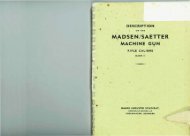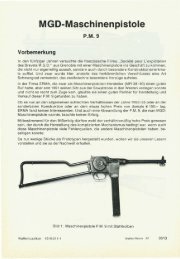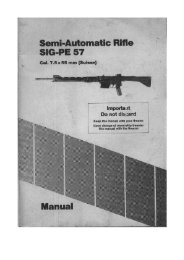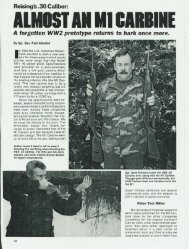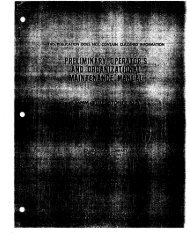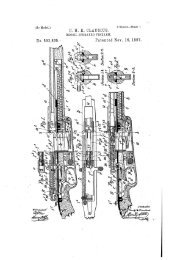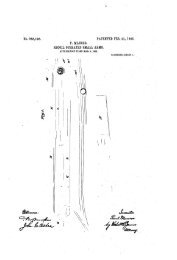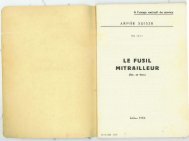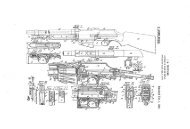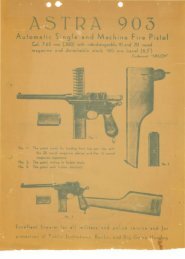The Parabellum Story (GunFacts).pdf - Forgotten Weapons
The Parabellum Story (GunFacts).pdf - Forgotten Weapons
The Parabellum Story (GunFacts).pdf - Forgotten Weapons
You also want an ePaper? Increase the reach of your titles
YUMPU automatically turns print PDFs into web optimized ePapers that Google loves.
About 1896 Loewe merged with the<br />
Deutsche Metallpatronenfabrik ( German<br />
Metallic Cartridge Co.) of Karlsruhe<br />
to form the Deutsche \,Yaffen<br />
und Munitions- fabriken (German<br />
<strong>Weapons</strong> and Munitions Co.) known<br />
throughout the world by its initials,<br />
DWM. Arms production remained at<br />
the old Loewe facilities in Berlin,<br />
while the Karlsruhe plant continued<br />
to make cartridges. Since this reorganization<br />
occurred in the midst of the<br />
Borchardt's brief six-year life span<br />
( 1893- 1899) the first pistols were<br />
marked " Waffenfabrik Loewe, Berlin,"<br />
while later production carried DWM<br />
inscriptions. Combined production totals<br />
only a few thousand pieces.<br />
Although the Borchardt pistol was<br />
tested by the U.S. Navy in 1894, the<br />
U.S. Army in 1897-98, and probably<br />
by Switzerland, Germany, and others<br />
as well, it never achieved either official<br />
adoption or widespread usage, and<br />
is notable for four reasons only:<br />
1. It was the first commercially<br />
successful se!Ooading pistol.<br />
2. It introduced the now universal<br />
practice of feeding cartridges from<br />
a detachable box magazine located<br />
within the pistol grip.<br />
3. It was highly advanced ballistically,<br />
chambering a 30 caliber<br />
out over the shooter's wrist. This dictated<br />
the midships position of the grip,<br />
made the gun cumbersome, and looked<br />
like hell. Hugo Borchardt, so the story<br />
goes, stubbornly refused to admit that<br />
his pistol was anything short of perfect,<br />
and so lost the place in history<br />
that Luger gained.<br />
Luger probably began redesigning<br />
the Borchardt late in 1897. Prototype<br />
transition pieces were made up in<br />
1898 and 1899, and although one or<br />
both were evidently tested by Swiss<br />
military authorities in Bern in November-December,<br />
1898 and again in<br />
Thun in May 1899, no examples of<br />
either transition model have survived.<br />
<strong>The</strong> next year, 1900, saw the introduction<br />
of the first true Luger, and<br />
the first gun to wear the famous DWM<br />
scrolled cypher. If elegance were the<br />
measure of a fine firearm, then this<br />
pistol could not be bettered. <strong>The</strong> 1900<br />
model was a beautiful gun, a seductive<br />
gun, and many discovered that<br />
with the Parabcllum, love at first sight<br />
would be an enduring passion.<br />
<strong>The</strong> Borchardt's monstrous recoil<br />
spring housing had been entirely eliminated;<br />
the recoil spring was now compactly<br />
housed just behind the magazine,<br />
inside the sharply raked grip.<br />
All screws, except for those holding the<br />
Th is is the Borchardt_ the design that swrted it all - toggle breech, magazine in grip,<br />
etc. Luger, in essence, simply compacted




